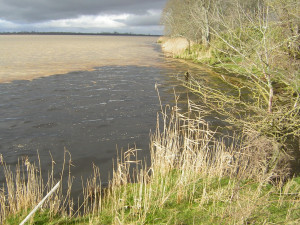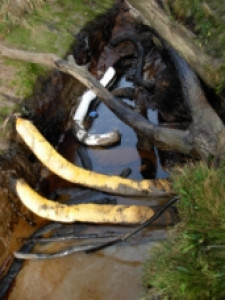The bottom of a 13,500 m³ containing 12,000 m³ of light crude oil tank ripped open at 8:00 am within an oil depot. The earthen dikes surrounding the retention basin withstood the wave effect; 2,000 m³ of oil still overflowed however the dikes. For the most part, this volume remained onsite and in the gutters, although 50 m³ reached the channels of the neighbouring swampland polluting 2 km of ditch network and reaching the superficial water table and 50 m³ did flow into the GARONNE. The tidal action contributed to polluting up to 40 km of banks on the GIRONDE, DORDOGNE and GARONNE Rivers.
The operator triggered the internal emergency plan and covered the retention basin with foam in order to prevent against the risk of inflammation and limit hydrocarbon and hydrogen sulphide (H2S) vapour dispersion. The authorities evacuated all 12 employees of neighbouring companies, established a safety perimeter, halted river navigation and traffic on the road and railway in the area, informed local populations and the nearby power plant, and measured the air quality. The products spilled into the gutters and retention basin were channelled towards the facility’s sedimentation basin and then transferred into empty reservoirs: in all, 6,000 m³ had to be pumped out.
The operator undertook pollution cleanup efforts (manual collection, dams, pumping, absorbent materials, use of dispersants, etc.) under the supervision of experts. Environmental associations and hunters dont notice significant impact on fauna. The products and wastes were disposed of in specific installations. Groundwater was also controlled. A total of 13,000 m³ of fire protection water charged with emulsifier (COD: 2.7 g/l) was stored prior to undergoing an activated sludge type of treatment onsite by means of extended aeration. Operation loss is estimated at more than 50 M euros.
A slight leak on the tank had been detected the previous day at 5:00 pm. The operator rescheduled at the following day in the morning the drainage into another tank due to the risks incurred by the operators and subcontracted personnel by having to block the tank’s floating roof at night. Water was injected at the bottom of the tank for the night. A control of the tank bottom in 2006 (on 100% of the bottom and 10 % of welding) mentioned the presence of corrosion on the tank bottom as well as losses of thickness reaching 80%. As a consequence, repair work had been performed and then verified. Moreover, the inspection report noted that no procedure had been outlined for managing the type of emergency situation that appeared the day before the tank failed.
This accident raises a number of questions about prevention means (conception: bottom, settlement; controls of the tank: frequency, modalities ), measures to take when a leak is detected (emergency procedure, emergency storage, drainage ) and protection devices against wave effects. A legal investigation was carried out.
Download the detailed report in .pdf format (540 Kb)





